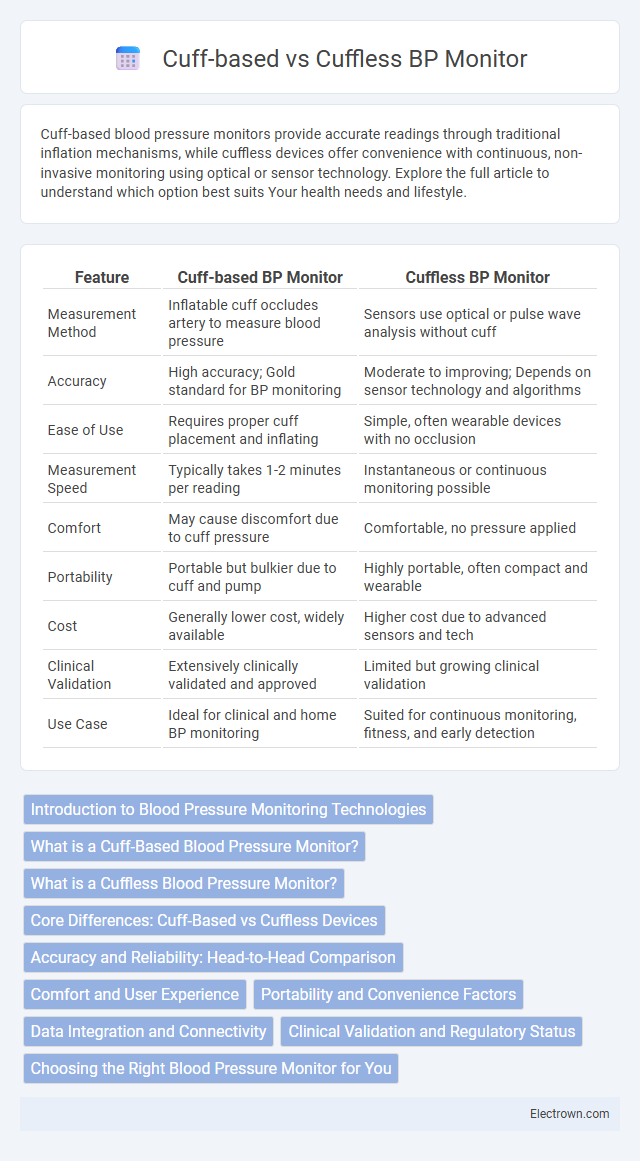Cuff-based blood pressure monitors provide accurate readings through traditional inflation mechanisms, while cuffless devices offer convenience with continuous, non-invasive monitoring using optical or sensor technology. Explore the full article to understand which option best suits Your health needs and lifestyle.
Table of Comparison
| Feature | Cuff-based BP Monitor | Cuffless BP Monitor |
|---|---|---|
| Measurement Method | Inflatable cuff occludes artery to measure blood pressure | Sensors use optical or pulse wave analysis without cuff |
| Accuracy | High accuracy; Gold standard for BP monitoring | Moderate to improving; Depends on sensor technology and algorithms |
| Ease of Use | Requires proper cuff placement and inflating | Simple, often wearable devices with no occlusion |
| Measurement Speed | Typically takes 1-2 minutes per reading | Instantaneous or continuous monitoring possible |
| Comfort | May cause discomfort due to cuff pressure | Comfortable, no pressure applied |
| Portability | Portable but bulkier due to cuff and pump | Highly portable, often compact and wearable |
| Cost | Generally lower cost, widely available | Higher cost due to advanced sensors and tech |
| Clinical Validation | Extensively clinically validated and approved | Limited but growing clinical validation |
| Use Case | Ideal for clinical and home BP monitoring | Suited for continuous monitoring, fitness, and early detection |
Introduction to Blood Pressure Monitoring Technologies
Cuff-based blood pressure monitors rely on inflatable cuffs to measure arterial pressure through occlusion and gradual deflation, providing accurate systolic and diastolic readings widely used in clinical settings. Cuffless blood pressure monitors utilize sensor technologies such as photoplethysmography (PPG), ECG, or pulse transit time (PTT) algorithms to estimate blood pressure continuously without the discomfort of inflation. Innovations in wearable devices and machine learning have advanced cuffless devices, offering convenience and potential for real-time health monitoring outside traditional environments.
What is a Cuff-Based Blood Pressure Monitor?
A cuff-based blood pressure monitor uses an inflatable cuff wrapped around the upper arm to temporarily restrict blood flow, measuring systolic and diastolic pressure as the cuff deflates. This traditional method provides accurate and clinically validated readings by detecting oscillations in the arterial wall. If you want precise blood pressure tracking, cuff-based monitors remain the gold standard for home and professional use.
What is a Cuffless Blood Pressure Monitor?
A cuffless blood pressure monitor measures blood pressure without the traditional inflatable cuff, utilizing sensors such as photoplethysmography (PPG) and electrocardiography (ECG) to estimate arterial pressure. These devices often rely on algorithms that analyze pulse wave velocity or pulse transit time to provide continuous, non-invasive readings. Cuffless monitors enhance user comfort and convenience, enabling frequent blood pressure tracking for hypertension management and cardiovascular health monitoring.
Core Differences: Cuff-Based vs Cuffless Devices
Cuff-based blood pressure monitors measure arterial pressure by inflating a cuff around the arm, providing highly accurate and clinically validated readings through occlusion and gradual release of blood flow. Cuffless devices utilize optical sensors, such as photoplethysmography (PPG), or ECG signals to estimate blood pressure continuously without physical restriction, favoring portability and user comfort. Core differences lie in their measurement methodology, accuracy level, user convenience, and suitability for clinical versus home or ambulatory monitoring scenarios.
Accuracy and Reliability: Head-to-Head Comparison
Cuff-based blood pressure monitors provide higher accuracy and reliability due to direct arterial compression, making them the clinical standard for precise measurements. Cuffless monitors utilize optical sensors and algorithms, offering convenience but often at the cost of reduced accuracy, especially during physical activity or irregular heartbeats. Studies consistently show cuff-based devices outperform cuffless alternatives in clinical settings, ensuring dependable readings critical for hypertension management.
Comfort and User Experience
Cuffless BP monitors offer superior comfort by eliminating the tight arm pressure common with traditional cuff-based devices, making them ideal for continuous, hassle-free monitoring. These monitors enhance user experience through easy, quick measurements without needing to position an inflatable cuff correctly. Your choice should consider daily convenience and comfort, especially if frequent blood pressure tracking is essential.
Portability and Convenience Factors
Cuffless blood pressure monitors offer superior portability due to their compact, wearable design, enabling continuous monitoring without the bulk and discomfort of traditional cuffs. These devices integrate seamlessly with smartphones and fitness trackers, providing real-time data and greater convenience for on-the-go users. In contrast, cuff-based monitors, while generally more accurate for clinical measurements, are less portable and require manual inflation, limiting ease of use outside home or medical settings.
Data Integration and Connectivity
Cuff-based blood pressure monitors typically offer robust data integration through Bluetooth or USB, enabling seamless syncing with smartphones and healthcare platforms for accurate tracking and analysis. Cuffless BP monitors leverage advanced sensors and AI algorithms to provide continuous blood pressure readings, with real-time data transmitted via wireless connectivity to mobile apps and cloud systems. Both devices enhance patient monitoring, but cuffless monitors prioritize convenience and constant data flow, while cuff-based models emphasize proven accuracy and standardized protocols for medical use.
Clinical Validation and Regulatory Status
Cuff-based blood pressure monitors have extensive clinical validation and are widely approved by regulatory bodies such as the FDA and CE, ensuring reliable and accurate readings for medical use. Cuffless BP monitors are emerging technologies with limited but growing clinical validation, often facing stricter regulatory scrutiny due to variability in measurement methods. Your choice should consider that cuff-based devices currently offer proven accuracy and regulatory compliance, essential for clinical decision-making.
Choosing the Right Blood Pressure Monitor for You
Choosing the right blood pressure monitor depends on accuracy, convenience, and your individual health needs. Cuff-based monitors provide precise readings through inflatable arm cuffs and are recommended for clinical accuracy, while cuffless monitors offer portability and ease of use with optical sensors but may sacrifice some precision. Your decision should balance the consistency of cuff-based devices with the flexibility and comfort of cuffless options to best suit your lifestyle and medical requirements.
Cuff-based vs Cuffless BP Monitor Infographic

 electrown.com
electrown.com